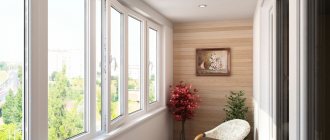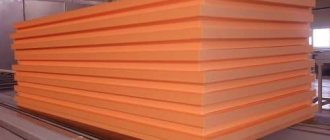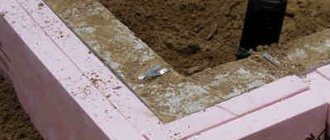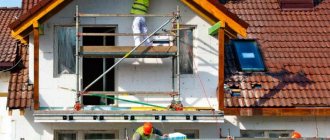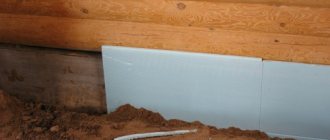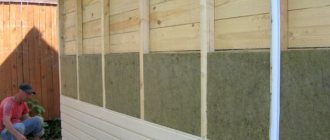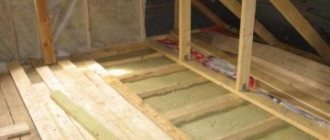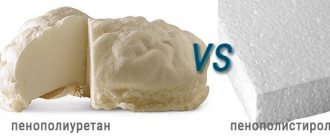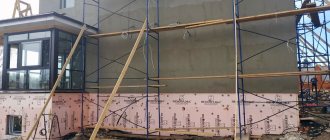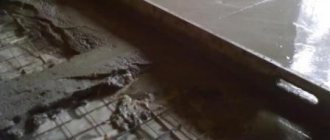A special feature of pile foundations is their ability to provide reliable and durable support for construction in the most problematic and difficult conditions.
Thanks to the pile system, the foundation is based not on unstable surface layers, often waterlogged or subject to periodic influxes of soil water, but on dense deep layers.
High mechanical strength of the support is achieved, independence from the level of groundwater.
The disadvantage of structures of this type is the impossibility of insulating the underground part of the foundation, in particular piles.
This creates favorable conditions for the formation of condensation in external areas, which contributes to the destruction and corrosion of materials.
Let's consider the available options for solving this problem.
Is it necessary to insulate a pile foundation?
Insulation of building structures is carried out for the sole purpose of stopping the formation of condensation. The prevailing opinion among most people that houses are insulated to reduce heat loss is wrong.
The main problem is wetting of walls and ceilings, rotting of wooden parts, and corrosion of metal elements. The process does not bypass concrete either - it is saturated with water, resulting in the formation of fungus or mold.
Sooner or later, the moisture freezes and, expanding, “explodes” concrete structures from the inside, which is dangerous for the condition of the entire building.
Therefore, it is pointless to talk about the benefits or expediency of insulation - this is an absolutely necessary procedure that allows you to normalize the indoor microclimate, prevent the destruction of materials, and extend the service life of the building.
However, there are often situations when, instead of insulation, it is necessary to install a cutoff that stops the contact of the foundation with warm internal air.
Therefore, before deciding to install a heat insulator, you should carefully analyze the physical essence of the current processes and determine how effective the insulation is in this case, or whether other actions are required.
Which insulation to choose
Many people do not know which insulation to choose for the basement. Therefore, you need to familiarize yourself with the recommendations in advance to help you make the right choice.
If the structure is located close to the ground, it should not be insulated with mineral wool. The fact is that it does not tolerate high humidity and therefore should not be allowed to get wet.
To insulate the foundation, it is better to use penoplex or expanded polystyrene. Penoizol and foam glass are also suitable.
Insulation methods
There are two methods of insulation:
Base
The essence of the method is to install a false base that blocks the possibility of outside air penetrating into the gap between the ground and the grillage.
There are two options:
- The basement itself is qualitatively insulated , the internal atmosphere and the underground space of the house communicate, as a result of which the latter maintains a fairly high temperature. This method is suitable for owners of houses on metal (screw) piles and in the presence of a technical underground with communications input. It becomes possible to periodically service the metal parts of the foundation and communication input fittings, and the danger of pipeline freezing disappears.
- The underground space is completely filled with a heat insulator . Expanded clay is usually used, which does not rot and is not susceptible to external influences. The only problem with the material is that when wet it takes a very long time to dry, so it is necessary to ensure reliable waterproofing of the base. This option is good for reinforced concrete (driven or bored) foundations that do not require regular maintenance. Continuous backfill allows for greater savings on heating costs and prevents the first floor from getting wet.
Ceilings (floors)
Floor insulation is carried out in cases where there is no need to increase the temperature of the subfloor. There are no open water pipelines, heating lines or other components that require operating temperatures.
In such cases, the installation of a false base is carried out only for decorative purposes and as a barrier to precipitation and snow. A hermetic cutoff from internal air is created, and a gap filled with a heat insulator is formed between it and the subfloor.
As an option, a layer of insulation is laid, after which a screed with a heated floor system is poured. As a result, effective heat saving of the ceiling and complete absence of condensation in the subfloor is ensured.
If necessary, it remains possible to periodically penetrate it and service metal parts (apply an anti-corrosion coating).
All common materials can be used as heat insulators, but, taking into account the specifics, the use of moisture-permeable types (mineral wool, ecowool, etc.) should be abandoned.
The best choice would be:
- Styrofoam . The correct name of the material is granulated polystyrene foam. It is the leader among thermal insulators due to the lowest price. This is a lightweight material produced in the form of slabs of various thicknesses. It practically does not interact with water, does not rot, retains heat well, and is easy to cut and process. Polystyrene foam granules contain carbon dioxide, so it does not support combustion.
- Penoplex . This material is called extruded polystyrene foam. It is a close relative of foam plastic, but is made using a different technology and is a continuous mass of frozen foam, rather than individual granules glued together. In all respects, it is slightly superior to foam, but has a higher price, so the demand for it is slightly lower.
- Liquid polyurethane foam . A material that allows you to insulate complex, curved and highly fragmented surfaces. It is applied by spraying, which requires special equipment. As a result, a sealed layer of insulation appears, absolutely resistant to water or biological manifestations, and reacts little to temperature changes. The only limiting factor is the relatively high price and the need to use special equipment.
NOTE!
There are many more materials that can be used for thermal insulation, but only the samples considered are the most popular. Mineral wool, as a hygroscopic heat insulator, is not taken into account.
Don't forget about waterproofing
Before you begin laying waterproofing material, it is necessary to treat all exposed wood or metal areas of the foundation. Antiseptic impregnation is applied to the wood, and the metal is coated with a primer. Drying time - up to 7 days. This is necessary to prevent the destruction of the material under the influence of moisture.
Waterproofing is also carried out for the same purpose. An inexpensive option is roofing felt, which is laid at the junction of the ends of the piles with the grillage, on the upper sides of the grillage and areas in contact with the wall.
DIY insulation technology
To insulate a pile foundation, it is necessary to perform a number of procedures that should be considered separately:
Construction of the basement
Typically, a false plinth (or, as it is commonly called, a fence) is a strip of sheet materials installed on a sheathing of bars.
This option is not suitable for high-quality insulation, since it is necessary to provide not only a supporting structure for the heat insulator, but also to form a strong and reliable cutoff for water.
Therefore, it is necessary first of all to build a brick plinth and a high-quality blind area, equipped with a thermal breaking strip.
This approach will completely eliminate soil wetting in the area of the pile field and create conditions for the full functioning of the heat insulator.
Insulation with decorative panels
Decorative panels are sheets of basement siding glued to sheets of thermal insulation (most often, penoplex). Installation of such panels allows you to combine decorative finishing and insulation in one procedure, which significantly saves time.
At the same time, the cost of purchasing panels significantly exceeds the cost of purchasing conventional heat insulators, and the quality of insulation is not the best. This option can be used in regions with relatively mild winters.
Styrofoam
The foam is installed from the inside of the base. The sheets are fastened using a tile adhesive solution; dowels with wide plastic washers are additionally used.
Installation is carried out as tightly as possible, without cracks or gaps. All detected gaps are immediately filled with polyurethane foam . The effectiveness of insulation depends on the thickness of the foam.
In practice, the most successful slab size is considered to be 50 mm, but in regions with frosty winters, thicker sheets can be used.
Penoplex
Installing penoplex is practically no different from the technique of installing polystyrene foam. The same materials and methods are used, the thickness of the penoplex is chosen based on the same considerations .
The efficiency of the material is slightly higher, but the main advantage is strength.
Penoplex does not crumble, as is typical for polystyrene foam. Installation of a heat insulator in difficult conditions occurs faster and with less losses.
Liquid polyurethane foam
This material is applied externally using special equipment. At the same time, you can create a completely sealed layer of any thickness.
In this case there are no cracks or gaps; the formed layer is absolutely sealed.
The material is convenient for insulating uneven surfaces with a lot of protruding elements. Due to its high price, it has not yet become widespread, but users who have used this type of insulator highly appreciate its performance qualities.
Curtain rods
A mandatory element of the design of suspended ceilings is curtain rods made of different materials. In accordance with the design of these products, they can be wall-mounted or ceiling-mounted, with the latter looking the most presentable. The complexity of their installation is due to the fact that the thin panel is not able to withstand the weight of heavy structures.
There are two ways to solve the problem with fastening the cornice:
- open;
- hidden.
After the canvas is stretched, the cornice is attached through the film to a wooden plank. Holes for self-tapping screws must be burned so that the molten edges prevent further rupture of the material.
With the hidden installation method, the cornice is fixed to the ceiling above the level of the suspended ceiling structure. A beam or corner is placed next to it for installing the guide molding. This work is performed before measurements are taken. Curtains hanging from the structure look impressive and harmoniously combine with different types of fabrics.
How to insulate a floor
Floor insulation is done in several ways:
- Creating a backfill layer of insulation between the bottom flooring and the subfloor.
- Continuous backfilling of the underground with arrangement of the floor on the ground.
- Construction of a deck with insulation and pouring of a heated floor system.
The choice of the optimal option is made based on existing conditions, configuration and availability of communications in the underground. The most common options include creating a layer of insulation between the bottom and subfloor and pouring a heated floor system.
The procedure in both options starts the same:
- Logs are installed . They must ensure the immobility and strength of the floor; ideally, they rest on the surface of the piles.
- Planks are attached to the lower edges of the joists, which will serve as sides for laying the flooring boards.
- The plank flooring is being laid . Edged boards are used, laid transversely between the joists.
- A heat insulator is laid on top of the boards . You can use polystyrene foam, penoplex. If the thickness is sufficient, expanded clay is used, but for effective service a layer of at least 30 cm is required, which is not always possible.
- A layer of waterproofing is laid.
After this, either subfloor materials are laid and the finishing coating is laid, or underfloor heating pipes are laid, all connections are made, functionality is checked, and then a layer of screed is poured (about 10 cm).
This option is gaining more and more supporters, as it allows you to heat the room economically and efficiently.
Necessary materials
To carry out the work, you need insulation and a profile pipe with a cross-section of 50x30 mm and a thickness of 2 mm.
From the tools:
- welding machine,
- screwdriver,
- building level.
Calculations
An important point is to correctly calculate the required amount of insulation and profile pipe. If there are surpluses left, it doesn’t matter. Well, if it’s not enough, you’ll have to go to the hardware store again.
As for the thermal insulation material, it is calculated taking into account the area it covers. This is the distance from the ground to the piping multiplied by the perimeter of the house.
Eg:
- house 10x10 m - perimeter 10x4=40 m;
- plinth height – 0.5 m.
The area of the covered surface is: 0.5x40 = 20 m. This means that this amount of insulation must be purchased. It is better to be 5-10% larger, because it is often necessary to trim to the required dimensions. You can save a lot if you choose a material with a width equal to the height of the base.
The profile pipe is laid on the piles in two rows . Accordingly, its quantity is determined by the double perimeter of the house. That is, in our case we will need 80 m of this material.
Thermal insulation of a wooden house
Depending on the height of the piles (and base), three insulation options are used:
- External insulation of the base, made around the entire perimeter.
- Internal floor insulation.
- Full insulation, performed both on the base and on the ceiling.
Wooden houses have higher heat-saving properties, so it is impossible to clearly name the most effective option. It is necessary to proceed from climate conditions, the amount of snow cover, structural features and other factors.
IMPORTANT!
However, judging by user reviews, the majority prefer to insulate the ceiling, and the base is only decorated in a decorative way and provides a shutoff from water.
Errors during work
The biggest mistake is leaving gaps in the thermal insulation layer . Even 1 mm will negate all efforts. In the defective area under the floor, the temperature will be lower. This means that one of the rooms will not warm up as needed.
Frost will begin to form under the floor. Condensation will appear, which will negatively affect the technical condition of metal and wooden products and insulation. That is, their service life will decrease.
You will find a lot of important and useful information about basement insulation in this section.
Thermal insulation technology for pile-screw foundations
To insulate a pile-screw foundation, it is necessary to proceed from the following requirements:
- It is necessary to ensure high-quality cutoff from moisture getting under the house.
- For periodic maintenance of piles and grillage, it is necessary to create access to the underground.
- High-quality thermal insulation should be ensured.
Pile-screw foundations usually have a wooden, less often a metal grillage. The simplest method of insulation is to install the sheathing along the pick-up line (false base), install penoplex slabs attached directly to it and install an outer layer of flat asbestos-cement slabs .
NOTE!
Alternatively, you can use moisture-resistant drywall. This technology allows you to get a warm false base without extra costs and expenses, to provide a relatively warm and dry space under the house, which will allow you to check the condition of the foundation and, if necessary, tint metal elements.
Pickup - what is it?
A pile foundation has one drawback, unlike a strip foundation: the space between the piles, as well as the soil and ceiling of the basement floor, does not have insulation. This is exactly why the fence is installed. By properly constructing this element, heat losses in winter can be reduced. It is also insulated from precipitation.
Methods for installing the fence are calculated for each specific case. The choice depends on many factors. The parameters may also differ, but there are generally accepted requirements: for example, the height of the fence must be at least 50 cm from the ground level. When constructed correctly, the fence is both an element of thermal insulation and an excellent aesthetic solution.
The pile foundation must have a blind area, which is required to drain water. This structure is made 80 cm wide, extending 25 cm beyond the cornice. This will ensure that water drains from the roof directly onto the blind area, which will protect the ground near the foundation from washing away.
The higher the flowability of the soil, the more organization of the blind area is required. Most often, its slope is done in a ratio of 1:5. It is also necessary to organize a moisture-proof layer. Instead of vegetation, which is removed before construction, a layer of clay is poured and compacted.
The blind area of any house on a pile foundation must be accompanied by a channel for drainage of water; its organization guarantees a long service life of the structure.
Construction of the blind area
A well-made blind area of a screw foundation is half of an excellent result, and therefore, during the installation of the blind area, it is necessary to delve into all the nuances of the process as thoroughly as possible. Work begins on creating such a structure as a foundation blind area by marking the site. This will make it easier to maintain the desired width around the perimeter of the entire tape. After this comes the turn of earthworks. At this stage, a trench of suitable width and depth is dug.
The next step in the process of constructing a blind area for the base is to form a cushion - first from clay and then from sand. Then a small layer of medium-fraction crushed stone is poured, on top of which a reinforcing mesh is placed. When all of the above work is completed, you can fill the structure with concrete and level it. This is approximately what the installation of the most basic blind area, made of concrete mortar, looks like.
To obtain maximum results, it is not enough to simply build a blind area for a pile foundation. It still needs to be insulated. For this purpose, a horizontal insulation method is used. First of all, the waterproofing layer is laid. The thermal insulation panels used must be highly durable. Otherwise, they may later be damaged due to the severity of the concrete mortar screed.
You can begin lining the blind area of the pile foundation only after the concrete has completely hardened. The cladding of the blind area has nothing to do with its technical characteristics; it performs an exclusively aesthetic function and is performed at will.
